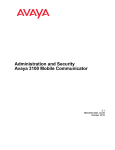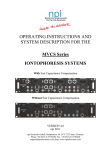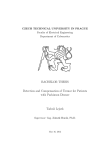Download User manual v1.0
Transcript
1 User Manual for the Spiking Neuron Basal Ganglia Model Version: 1.0 14/12/2006 Mark D. Humphries [email protected] Abstract The spiking neuron model of the basal ganglia was developed over a period of 6 years, and the resulting code-base reflects the complexity of this process. These notes are intended to guide the end-user through the basic structure and use of the code. Please e-mail any suggestions, requests, or queries for incorporation into future revisions. 1 Introduction The following is a short user manual for the spiking neuron basal ganglia (BG) model, guiding the user through the basic steps of calling the correct functions, and how the results presented in the Journal of Neuroscience paper (Humphries et al., 2006) were analysed. It is anticipated that the copious Help sections and comments throughout the code will be sufficient to understand the detail. All names in bold are MATLAB functions or scripts. All custom MATLAB functions have full Help comments describing their function calls. The code is provided in exactly the form in which we used it, and so there are some inevitable historical oddities (comments not matching text, redundant parameters etc). Nevertheless, by doing this we can ensure that our results are replicable! Unpack both ZIP files to a single directory, then add that directory and all its sub-directories to your MATLAB path. 2 Basic code The central function is BATCH BG heterogenous AMPA NMDA, which accepts five arguments including a string containing the filename of the parameters file. Every user-definable parameter is contained in this file, so that BATCH BG heterogenous AMPA NMDA only requires editing if new structures (e.g. thalamus, cortex) are added to the model. A second version BATCH BG heterogenous AMPA NMDA2 has the additional flexibility of assigning separate weights to the AMPA and NMDA receptors, though this was only used in (Humphries et al., 2006) to study the effects of NMDA receptor blockade on the γ-band activity. These functions call in turn: 1. BG GHS input, which generates the cortical input streams according to the values set in the parameters file. 2. BG net shunt AMPA NMDA, which creates the network specified in the parameters file. The random number generator is reset before this function is called to ensure that the same network is specified each time for a given parameter set. In turn, this function calls • PSPtoPSC, which converts the post-synaptic potential size, give in volts within the parameters file, into the appropriate current step that should be elicited by the arrival of a spike at the pre-synaptic membrane (given the post-synaptic neuron’s average membrane properties). 2 3. GHS LIF solver shunt AMPA NMDA, which simulates the specified network for the specified time period, given the specified inputs. This is a MEX-file, compiled from the original C. Compiled versions exist for Windows XP, Linux, and 64-bit Linux, but compiling a MEX file for any system is straight-forward. 2.1 The parameters file A full parameters file is typified by the pars script. The most altered parameters appear at the top of the file, including global dopamine level, simulation time, and input type and rates. After this is a section which specifies the global network parameters (number of neurons per channel, and so on), followed by parameters for each class of neuron. These are followed by weights and transmission delays, coefficients for the STN and GP dopamine models, shunting inhibition parameters, intrinsic currents (driving spontaneous and burst firing), and the option of including injection currents. All parameter values are given in SI units (seconds, amps, volts etc) where required. This avoids the inevitable errors that occur in the worryingly common practice of working in “physiological” units (ms, pA, mV etc). 2.2 Undocumented parameters There are some parameters in the code that are not mentioned in (Humphries et al., 2006) because they were not used. However, they may be useful in future experiments, and so we briefly describe them here. 1. trace n the neuron given here (e.g. GPe(75) is the 75th GPe neuron) has complete traces of some of its variables saved in the results file from BATCH BG heterogenous AMPA NMDA. gabaa The current list is: distal inhibitory synaptic input Ij∈∆ , membrane potential V m , and i total gating variable Qh . The variables that are saved can be edited in GHS LIF solver shunt AMPA NMDA, and a commented-out list of suggestions is included in that code (don’t forget to re-compile after editing). 2. ref resets the membrane potential to this value after a spike is fired. This allows for explicit after-hyperpolarisation to be modeled if required, though does introduce small numerical errors as the analytic solution to V m does not account for this. 3. STN ext ratio will scale the cortical-subthalamic weight to be this fraction of the corticalstriatal weight. 4. PSP sigma standard deviation of (normally-distributed) noise for post-synaptic potential size. Allows for separate parameterisation of synaptic noise (due to e.g. spike failure or graded vesicle release) from membrane noise. 5. Injection current (end of script): the simulation code contains the ability to inject a current pulse train of specified width and frequency into user-selected cells. This allows for simple replications of current injection studies in intact BG. 2.3 The simulation engine Our central simulation engine GHS LIF solver shunt AMPA NMDA was written in C to gain a vast performance increase over native MATLAB code. It uses a mixed time-driven/eventdriven system, where each neuron’s membrane potential is updated every time-step, but its synaptic input is only processed when an pre-synaptic event occurs (and accounting for the transmission delay). We feel this achieves a good trade-off for analytically solvable model 3 neurons between the flexibility of a time-driven system and the efficiency of an event-driven system. The C code was written for optimal performance, and as such is not particularly humanreadable. We made full use of the analytically solvable neuron model by moving all constants outside of the neuron update loop (they are computed in BATCH BG heterogenous AMPA NMDA before the simulation engine is called). This enabled us to achieve faster than real-time performance (i.e 5 seconds of simulation time took less than 5 seconds of computation) on a modest desktop PC (Intel P4, 2.4 GHz) for models with thousands of neurons. (Also note that the random number generator is given in full in the code, based on the modified Ziggurat method of Marsaglia and Tsang, 2000). If extensions to this code are required, such as a new neuron model, please contact us and we would be happy to help modify the simulation engine. 3 Code for structuring the simulations Much of the code-base is devoted to the structure of the simulations. The central function is models as individuals, which sets up our “models-as-animals” simulation protocol: see Humphries and Gurney (2007) for why we think this is a good idea. The basic idea is briefly explained on p.12925 of the Journal of Neuroscience paper: when replicating a particular condition of an experimental study, we ran as many simulations as there were animals in that condition, and sample the same number of cells per model as were sampled (on average) per animal. For example, in the control condition of Magill et al. (2001) slow-wave oscillation study they used 7 rats, sampling a total of 28 subthalamic nucleus (STN) cells and 18 globus pallidus (GP) cells. To emulate this condition, we therefore ran 7 models (all with the same parameter set), sampling 4 cells from each STN (giving a total of 28 model STN neurons) and 3 cells from each GP (giving a total of 21 model GP neurons). We term this batch of simulations a “virtual experiment”. We run multiple batches (usually 50) to better understand the spread of results predicted by the model. All of this process — the multiple simulations, sampling of cells, batches and so on — is automated by models as individuals and the functions it calls (in addition to those already listed, extract spikes performs the sampling operation; other functions are discussed below). Each simulated experimental condition is run by a top-level function single runX, which calls models as individuals with the parameters necessary for emulating that experiment’s structure: • number of batches to run • number of models in a batch (single virtual experiment) • which structures to sample from • the number of cells to sample from each structure in each model • the extraction threshold — not used in (Humphries et al., 2006). This sets a threshold level (in spikes/s) for the minimum mean firing rate a cell must have to be considered for sampling. The effects of systematic sampling bias in micro-electrode recordings can be emulated by setting this to a positive value. and with: • the file path for saving all output files • the name of the parameter file associated with that experiment • the name of the analysis flag file for that experiment (see below) 4 • an identifying name for that experiment (used as prefix for the output files) • the type of analysis required, if any (see below). 3.1 Selection and switching experiments These are handled differently to the rest of the model experiments, as they require running a large batch of simulations on a single model. If models as individuals is invoked with the type parameter set to the string ‘sel’, then it in turn calls batch selection grid DA. This function runs a complete batch on a single model, one simulation per row in the array input array, which is loaded from the MAT file input grid ∗ . The results of the batch are each classified as no selection, selection, switching, dual selection, or interference (by the function mean output). The selection threshold θs is specified within the batch selection grid DA function. 4 Running the simulations For simple simulations, BATCH BG heterogenous AMPA NMDA can be invoked directly from the MATLAB command line, with appropriate arguments (see its Help comments). This will require a suitable parameter file, for which any of the supplied set will suffice. We consider the file pars as the baseline state of the model, being the nominal “quiescent” in vivo state of the BG. Table 1 lists the single runX and parameter files that correspond to each published study in (Humphries et al., 2006). To run an existing experiment with the model, do the following: 1. edit pathroot variable in the appropriate single runX function so that it points to a suitable directory for the storage of the output files. 2. invoke that function at the command line in MATLAB. Use these single runX and parameter files as templates for further experiments with the model. For example, to look at the effects of a systemic D1 agonist on the γ-band oscillations, copy and rename single run6a and pars6a. Edit the renamed single runX function to include the new name for the parameter file, a new experiment name, and an appropriate path; edit the parameter file, setting dop1 = 1. Then invoke the new single runX function from the MATLAB command line. 5 Analysing the results 5.1 A single simulation A single run of BATCH BG heterogenous AMPA NMDA results in a single output file in MAT format, which contains most of the important simulation parameters (to allow future reconstruction of the simulation) and the spike data in a compressed format. Output spikes are encoded in two arrays: the first in t contains the time-step indices of all spikes in the order they occurred; the second in n contains the corresponding index of the neuron that emitted the spike. Similarly, the simulated cortical input spike trains are encoded in the corresponding out t and out n arrays. My MATLAB toolbox of analysis functions is provided (LIFtools/Analysis). Each has a detailed Help section. Each typically requires a single neuron’s time-series as its first argument. For neuron X, this can be extracted in MATLAB from the spike encoding arrays thus: ∗ For historical reasons, the actual values in input array are scaled down by a constant factor specified in the pars file, and it is the scaled values reported in the paper 5 Table 1: Table of files corresponding to each experimental study in (Humphries et al., 2006). DA: dopamine; LFO: low frequency oscillation Experiment Simulation file Parameter file Analysis flag file Tonic rates, collaterals Tonic rates, no collaterals Selection and switching Selection and switching, low DA Selection and switching, high DA LFO: control LFO: cortical ablation LFO: DA lesion LFO: cortical ablation and DA lesion LFO: control, no STN/GP DA LFO: ablation, no STN/GP DA LFO: DA lesion, no STN/GP DA LFO: ablation and DA lesion, no STN/GP DA LFO: control, no STN DA LFO: ablation, no STN DA LFO: DA lesion, no STN DA LFO: ablation and DA lesion, no STN DA LFO: control, no GP DA LFO: ablation, no GP DA LFO: DA lesion, no GP DA LFO: ablation and DA lesion, no GP DA LFO: control, no collaterals LFO: ablation, no collaterals LFO: DA lesion, no collaterals LFO: ablation and DA lesion, no collaterals LFO: control, no urethane LFO: ablation, no urethane LFO: DA lesion, no urethane LFO: ablation and DA lesion, no urethane LFO: ablation and DA lesion, no Ca2+ in STN γ-band: control γ-band: D2 agonist γ-band: NMDA blocker in GP single single single single single single single single single run1 run1b run2 run3a run3b run4a run4b run4c run4d pars pars1b pars2 pars3a pars3b pars4a pars4b pars4c pars4d sum sum sum sum sum sum flags flags single single single single run5 run5 run5 run5 1a 1b 1c 1d pars5 pars5 pars5 pars5 1a 1b 1c 1d sum sum sum sum flags45 flags45 flags45 flags45 single single single single run5 run5 run5 run5 2a 2b 2c 2d pars5 pars5 pars5 pars5 2a 2b 2c 2d sum sum sum sum flags45 flags45 flags45 flags45 single single single single run5 run5 run5 run5 3a 3b 3c 3d pars5 pars5 pars5 pars5 3a 3b 3c 3d sum sum sum sum flags45 flags45 flags45 flags45 single single single single run5 run5 run5 run5 4a 4b 4c 4d pars5 pars5 pars5 pars5 4a 4b 4c 4d sum sum sum sum flags45 flags45 flags45 flags45 single single single single run5 run5 run5 run5 5a 5b 5c 5d pars5 pars5 pars5 pars5 5a 5b 5c 5d sum sum sum sum flags45 flags45 flags45 flags45 flags45 flags45 flags45 flags45 single run5 6d pars5 6d sum flags45 single run6a single run6b single run6c pars6a pars6b pars6c sum flags6 sum flags6 sum flags6 6 >> idx = find(in_n == X); >> times = in_t(idx) * dt; % array index of all events for that neuron % corresponding time-steps, converted to seconds We have also included the Chronux toolbox (Jarvis and Mitra, 2001) that we used as a separate ZIP file. The latest version can be downloaded from chronux.org if required. 5.2 A simulation batch The models as individuals function deletes all the individual output files that each call to BATCH BG heterogenous AMPA NMDA creates, after the appropriate spike trains has been extracted. It then calls a user-specified function to analyse each individual spike train (for the published work, this was batch analyse stngpe). A further user-specified function (for the published work, this was combine stngpe analysis) is called at the end of each batch to pool all of the analyses from the batch into a single file. The output filenames from each of these two analysis processes are stored in a single file covering all batches. The batch analyse stngpe function we supply contains a fairly exhaustive list of analyses, invoking many of the individual spike-train analysis functions in the supplied MATLAB toolbox. A user-defined analysis flag file determines which of these analyses is actually carried out for a given type of experiment (see e.g. sum flags. The function that combines the analyses also makes use of this flag file so that it knows which analyses to combine. Finally, there are a set of post-processing scripts (in directory Postproc/) which take the final filename list for all batches and automate comparisons of the analysed results across experimental conditions. These scripts save much of their output into ASCII format files, suitable for importing into graphing programs. References Humphries, M. D. and Gurney, K. (2007). A means to an end: validating models by fitting experimental data. Neurocomputing. in press. DOI: 10.1016/j.neucom.2006.10.061. Humphries, M. D., Stewart, R. D., and Gurney, K. N. (2006). A physiologically plausible model of action selection and oscillatory activity in the basal ganglia. J Neurosci, 26:12921–12942. Jarvis, M. R. and Mitra, P. P. (2001). Sampling properties of the spectrum and coherency of sequences of action potentials. Neural Comput, 13(4):717–749. Magill, P. J., Bolam, J. P., and Bevan, M. D. (2001). Dopamine regulates the impact of the cerebral cortex on the subthalamic nucleus-globus pallidus network. Neuroscience, 106:313– 330. Marsaglia, G. and Tsang, W. W. (2000). The ziggurat method for generating random variables. J Stat Soft, 5(8).
















